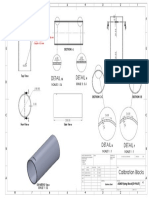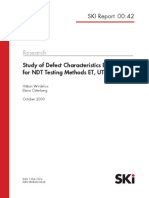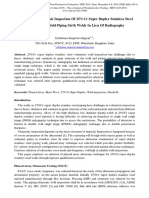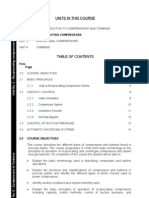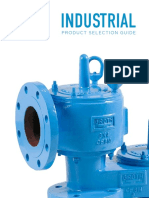NDT Remote Field Testing
NDT Remote Field Testing
Uploaded by
Kha MnCopyright:
Available Formats
NDT Remote Field Testing
NDT Remote Field Testing
Uploaded by
Kha MnOriginal Description:
Copyright
Available Formats
Share this document
Did you find this document useful?
Is this content inappropriate?
Copyright:
Available Formats
NDT Remote Field Testing
NDT Remote Field Testing
Uploaded by
Kha MnCopyright:
Available Formats
Remote Field Testing (RFT) Remote Field Testing or "RFT" is one of several electromagnetic testing methods commonly employed
in the field of nondestructive testing. Other electromagnetic inspection methods include magnetic flux leakage, conventional eddy current and alternating current field measurement testing. Remote field testing is associated with eddy current testing and the term "Remote Field Eddy Current Testing" is often used when describing remote field testing. However, there are several major differences between eddy current testing and remote field testing which will be noted in this section. RFT is primarily used to inspect ferromagnetic tubing since conventional eddy current techniques have difficulty inspecting the full thickness of the tube wall due to the strong skin effect in ferromagnetic materials. For example, using conventional eddy current bobbin probes to inspect a steel pipe 10 mm thick (such as what might be found in heat exchangers) would require frequencies around 30 Hz to achieve the adequate I.D. to O.D. penetration through the tube wall. The use of such a low frequency results in a very low sensitivity of flaw detection. The degree of penetration can, in principle, be increased by the use of partial saturation eddy current probes, magnetically biased probes as well as pulsed saturation probes. However, because of the large volume of metal present as well as potential permeability variations within the product, these specialized eddy current probes are still limited in their inspection capabilities. The difficulties encountered in the testing of ferromagnetic tubes can be greatly alleviated with the use of the remote field testing method. The RFT method has the advantage of allowing nearly equal sensitivities of detection at both inner and outer surfaces of a ferromagnetic tube. The method is highly sensitive to variations in wall thickness and tends to be less sensitive to fill-factor changes between coil and tube. RFT can be used to inspect any conducting tubular product, but it is generally considered to be less sensitive that conventional eddy current techniques when inspecting nonferromagnetic materials. RFT Theory of Operation A probe consisting of an exciter coil and one or more detectors is pulled through the tube. The exciter coil and the detector coil(s) are rigidly fixed apart at an axial distance of two tube diameters or more. The exciter coil is driven with a relatively low frequency, sinusoidal current producing a magnetic field. This changing magnetic field induces strong circumferential eddy currents which extend axially, as well as radially in the tube wall.
These eddy currents, in turn, produce their own magnetic field, which opposes the magnetic field from the exciter coil. Due to resistance in the tube wall and imperfect inductive coupling, the magnetic field from the eddy currents does not fully counterbalance the magnetic exciting field. However, since the eddy current field is more spread out than the exciter field, the magnetic field from the eddy currents extends farther along the tube axis. The interaction between the two fields is fairly complex but the simple fact is that exciter field is dominant near the exciter coil and the eddy current field becomes dominant at some distance away from the exciter coil.
The receiving coils are positioned at a distance where the magnetic field from the eddy currents is dominant. In other words, at a distance where they are unaffected by the magnetic field from the exciter coil but can still adequately measure the field strength from the secondary magnetic field. Electromagnetic induction occurs as the changing magnetic field cuts across the pick-up coil array. By monitoring the consistency of the voltage induced in the pick-up coils one can monitor changes in the test specimen. The strength of the magnetic field at this distance from the excitation coil is fairly weak but it is sensitive to change in the pipe wall from the I.D to the O.D.
The Zones
Direct Couple Zone The region where the magnetic field from the exciter coil is interacting with the tube wall to produce a concentrated field of eddy currents is called the direct field or direct coupled zone. This zone does not contribute a great deal of useful data to the RFT inspection due to problems with rather high noise levels due to the very intense varying magnetic field from the excitation coil. Transition Zone The region just outside the direct couple zone is known as the transition zone. In this zone there is a great deal of interaction between the magnet flux from the exciter coil and the flux induced by the eddy currents. As can be seen in the graph, the interaction of the two opposing fields is strongest near the ID of the tube and fairly subtle at the OD of the tube. The "resultant" field strength (the magnetic field that the sum of the two fields) in this region tends to change abruptly on the ID due to the interaction of the fields with differing directional characteristics of the two fields.
The receiver coil's signal phase with respect to the exciter coil, as a function of distance between the two coils is also shown in the graph. When the two coils are directly coupled and there is no interference from a secondary field, their currents are in phase as seen at location zero. In the transition zone, it can be seen that the phase swiftly shifts, indicating the location where the magnetic field from the eddy currents becomes dominate and the start of the remote field. Remote Field Zone The remote field zone is the region in which direct coupling between the exciting coil and the receiver coil(s) is negligible. Coupling takes place indirectly through the generation of eddy currents and their resulting magnetic field. The remote field zone starts to occur at approximately 2 tube diameters away from the exciter coil. The amplitude of the field strength on the OD actually exceeds that of the ID after an axial distance of approximately 1.65 tube diameters. Therefore, RFT is sensitive to changes in the material that are at the OD of the tube as well as the ID. RFT Probes Probes for inspection of pipe and tubing are typically of the bobbin (ID) variety. These probes use either a single or dual excitation coil to development an electromagnetic field through the pipe or tube. The excitation coils are driven by alternating current. The sensing coil or coils are located a few tube diameters away in the remote field zone. Probes can be used in differential or absolute modes for detection of general discontinuities, pitting, and variations from the I.D. in ferromagnetic tubing. To insure maximum sensitivity, each probe is specifically designed for the inside diameter, composition, and the wall thickness of a particular tube.
RFT Instrumentation Instruments used for RTF inspection are often dual use eddy current / RFT instruments employing multi-frequency technology. The excitation current from these instruments is passed on to the probe that contains an exciter coil, sometimes referred to as the driver coil. The receiving coil voltage is typically in the microvolt range so an amplifier is required to boost signal strength. Certain systems will incorporate a probe excitation method known as multiplexing. This utilizes an extreme high speed switching method that excites the probe at more that one frequency in sequence. Another method of coil excitation that may be used is simultaneous injection. In this coil stimulation technique, the exciter coil is excited with multiple frequencies at the same time while incorporating filter schemes that subtract aspects of the acquired data. The instrument monitors the pickup coils and passes the data to the display section of the instrument. Some systems are capable of recording the data to some type of storage device for later review.
RFT Signal Interpretation The signals obtained with RFT are very similar to those obtained with conventional eddy current testing. When all the proper conditions are met, changes in the phase of the receiver signal with respect to the phase of the exciter voltage are directly proportional to the sum of the wall thickness within the inspection area. Localized changes in wall thickness result in phase and amplitude changes. These changes can be indicative of defects such as cracks, corrosion pitting or corrosion/erosion thinning.
RFT Calibration Standards Calibration standards for RFT inspection of tubular products come in many variations. In order to produce reliable and consistent test results the material used for manufacturing calibration standards must closely match the physical and chemical properties of the inspection specimen. Some of the important properties that must be considered include conductivity, permeability and alloy content. In addition tube dimensions including I.D., O.D. and wall thickness must also be controlled. Just as important in selection of the correct material properties and tube dimensions used in producing calibration standards, the type of damage mechanisms that are expected to be encountered must also be considered. In order to get accurate quantative data, artificial discontinuity conditions are typically machined into the standards that will closely match those conditions that may be found in the tubing bundle.
You might also like
- Polar N 78 Plus EngDocument4 pagesPolar N 78 Plus EngabdiNo ratings yet
- Carlos Nunes Silva Handbook of Research On E-Planning ICTs For Urban Development and MonitoringDocument546 pagesCarlos Nunes Silva Handbook of Research On E-Planning ICTs For Urban Development and Monitoringshrikalani100% (1)
- Aectp-300 Edd v1 eDocument462 pagesAectp-300 Edd v1 eLjubomirSinđelićNo ratings yet
- Example Report TOFD 2 INT-GP1186!09!70Document1 pageExample Report TOFD 2 INT-GP1186!09!70EMTC EMTC100% (1)
- IrisDocument16 pagesIrisvibinkumarsNo ratings yet
- Ect MAD 8D Calibration Procedure: Using The Vertical Volts MethodDocument7 pagesEct MAD 8D Calibration Procedure: Using The Vertical Volts MethodShanmukhaTeliNo ratings yet
- RFTDocument39 pagesRFTGustavo Adolfo Rondon Zabala100% (1)
- Aboveground Storage Tank Training Rev 1Document18 pagesAboveground Storage Tank Training Rev 1Kha Mn100% (2)
- Brief On RFET Based Systems & ServicesDocument3 pagesBrief On RFET Based Systems & ServicesKollabo SysNo ratings yet
- Remote Field Technique (RFT)Document2 pagesRemote Field Technique (RFT)Abdul Moeed KalsonNo ratings yet
- Remote Field TestingDocument8 pagesRemote Field TestingthinhlvtNo ratings yet
- Remote-Field Testing (RFT)Document3 pagesRemote-Field Testing (RFT)shahgardezNo ratings yet
- P 14 Cover Sheets 10 07Document4 pagesP 14 Cover Sheets 10 07carlos100% (1)
- Advances in Tube Testing 2008Document39 pagesAdvances in Tube Testing 2008AhmedA.Hassan100% (1)
- Remot Field Testing Procedure IUDocument13 pagesRemot Field Testing Procedure IUDanielNo ratings yet
- PA Probe Catalog en 201304Document24 pagesPA Probe Catalog en 201304Durgamadhaba Mishra100% (2)
- ISOndtDocument8 pagesISOndtNooruddin SheikNo ratings yet
- Procedure Setup and Calibrate ECT DefHiDocument38 pagesProcedure Setup and Calibrate ECT DefHivikramNo ratings yet
- MultiView 6.1 EN 201204Document12 pagesMultiView 6.1 EN 201204bian_barker100% (2)
- Electromagnetic Testing-EMT-ACFM Chapter 10b-LibreDocument237 pagesElectromagnetic Testing-EMT-ACFM Chapter 10b-Libresafeer ahmad100% (1)
- 1.TOFD Coursenote (TWI)Document151 pages1.TOFD Coursenote (TWI)garapiaNo ratings yet
- ET Level III MalaysiaDocument2 pagesET Level III MalaysiaKuppan Srinivasan100% (1)
- Guided Wave and WeldingDocument44 pagesGuided Wave and Weldingharoub_nas100% (1)
- ToFD Poster NEWDocument1 pageToFD Poster NEWnavita100% (2)
- RFT ProcedureDocument9 pagesRFT ProcedurevikramNo ratings yet
- Tube Inspection DatasheetDocument10 pagesTube Inspection DatasheetMuhammad Noor FadhliNo ratings yet
- Asme Piping Block (Ut+Paut)Document1 pageAsme Piping Block (Ut+Paut)Muhammed Abo-FandoodNo ratings yet
- PA Caracterization BlockDocument2 pagesPA Caracterization BlockMuallim MursyidNo ratings yet
- Ultrasonic Testing CastingsDocument38 pagesUltrasonic Testing CastingsWuhan Kalls100% (1)
- Advances in Phased Array Weld Inspection Scan Plan DesignsDocument18 pagesAdvances in Phased Array Weld Inspection Scan Plan Designshcmcrlho100% (1)
- MFL Compendium - 001Document26 pagesMFL Compendium - 001kingston100% (2)
- Tube Inspection InsertDocument2 pagesTube Inspection InsertManish SharmaNo ratings yet
- 01-Introduction To OMNIDocument19 pages01-Introduction To OMNIvibinkumars100% (1)
- Level IiiDocument3 pagesLevel IiiMangalraj MadasamyNo ratings yet
- Guidelines For The Preparation and Grading of NDTDocument4 pagesGuidelines For The Preparation and Grading of NDTL...nNo ratings yet
- Beamtool Scan Plan Inspection Layout: 25Mm 200Mm 100Mm 0Mm Steel 1020 3.24Mm/Μs 5.89Mm/ΜsDocument3 pagesBeamtool Scan Plan Inspection Layout: 25Mm 200Mm 100Mm 0Mm Steel 1020 3.24Mm/Μs 5.89Mm/Μsநந்த குமார் சம்பத் நாகராஜன்No ratings yet
- Study of Defect Characteristics Essential For ET UT RTDocument58 pagesStudy of Defect Characteristics Essential For ET UT RTaldeanucu100% (2)
- 8.1 UT Lecture-Defect Sizing and EvaluationDocument24 pages8.1 UT Lecture-Defect Sizing and EvaluationNikhil KashyapNo ratings yet
- Remote Field Testing: HapterDocument20 pagesRemote Field Testing: HapterKalai VananNo ratings yet
- Guided Wave Presentation NDT Global 1Document41 pagesGuided Wave Presentation NDT Global 1Ahmed Lepda100% (1)
- Ultrasonic Test Procedure1Document8 pagesUltrasonic Test Procedure1MHDNo ratings yet
- High Temperature Ultrasonic ScanningDocument7 pagesHigh Temperature Ultrasonic ScanningscribdmustaphaNo ratings yet
- Ut of Austenitic WeldsDocument46 pagesUt of Austenitic Weldslinhcdt3100% (1)
- Module 4 PDFDocument72 pagesModule 4 PDFMACLIN JOHN VASANTH KNo ratings yet
- MX2 Training Program 04B Phased Array ProbesDocument49 pagesMX2 Training Program 04B Phased Array ProbesVictor Antonio Diaz FaundezNo ratings yet
- OmniSX MX2 Training 4C Phased Array WedgesDocument37 pagesOmniSX MX2 Training 4C Phased Array WedgescarlosNo ratings yet
- Pana USDocument52 pagesPana USflorin100% (1)
- ECT Inspection Technique: Setup and CalibrationDocument19 pagesECT Inspection Technique: Setup and CalibrationAbhishek DevarajNo ratings yet
- MX2 Training Program 04C Phased Array WedgesDocument38 pagesMX2 Training Program 04C Phased Array WedgesVictor Antonio Diaz Faundez100% (2)
- U.T ProcedureDocument10 pagesU.T ProceduretreyX67No ratings yet
- Eddy Current Tube TestingDocument6 pagesEddy Current Tube TestingSuresh Senanayake100% (1)
- Phased Array Scan Coverage - Ed GinzelDocument17 pagesPhased Array Scan Coverage - Ed GinzelJ.Carrasco100% (2)
- Super Duplex Con PADocument8 pagesSuper Duplex Con PAanon_447449056No ratings yet
- Advanced Ultrasonic Techniques For Nondestructive Testing of Austenitic and Dissimilar Welds in Nuclear FacilitiesDocument10 pagesAdvanced Ultrasonic Techniques For Nondestructive Testing of Austenitic and Dissimilar Welds in Nuclear FacilitiesAnonymous 5qPKvmuTWCNo ratings yet
- Ut Procedure Selon AsmeDocument9 pagesUt Procedure Selon AsmeMajdi JerbiNo ratings yet
- 1.2 TOFD Digitization Principles 2010Document35 pages1.2 TOFD Digitization Principles 2010Hoang Diep PhanNo ratings yet
- UT Thickness EbookDocument48 pagesUT Thickness EbookKalaiselvan toNo ratings yet
- Ultrasonics Examination Part 3Document3 pagesUltrasonics Examination Part 3JlkKumarNo ratings yet
- Guia Calibracion TofdDocument47 pagesGuia Calibracion Tofdinspeccion_179116669100% (2)
- Inspection In Manufacturing A Complete Guide - 2020 EditionFrom EverandInspection In Manufacturing A Complete Guide - 2020 EditionNo ratings yet
- Unit 1 Pump TerminologyDocument44 pagesUnit 1 Pump TerminologyKha Mn100% (1)
- Unit 4 Gas Fractionation PlantDocument16 pagesUnit 4 Gas Fractionation PlantKha Mn100% (2)
- Unit 3 Fractionation & Distillation EquipmentDocument15 pagesUnit 3 Fractionation & Distillation EquipmentKha Mn100% (1)
- Unit 07 Basic Principles of HydraulicsDocument10 pagesUnit 07 Basic Principles of HydraulicsKha MnNo ratings yet
- Unit 2 The Refrigeration TrainerDocument9 pagesUnit 2 The Refrigeration TrainerKha MnNo ratings yet
- TIASA - Thermal Insulation HandbookDocument58 pagesTIASA - Thermal Insulation HandbookSirGawain99No ratings yet
- Unit 1 Introduction To RefrigerationDocument13 pagesUnit 1 Introduction To RefrigerationKha MnNo ratings yet
- TurbinesDocument11 pagesTurbinesKha MnNo ratings yet
- Reciprocating CompressorDocument12 pagesReciprocating CompressorKha Mn100% (6)
- Centrifugal CompressorDocument13 pagesCentrifugal CompressorKha Mn86% (7)
- Intro To Compressor and TurbinesDocument20 pagesIntro To Compressor and TurbinesKha Mn100% (1)
- Guide On Geometric Design of RoadDocument113 pagesGuide On Geometric Design of RoadKha Mn100% (2)
- Malaysia Port ListDocument10 pagesMalaysia Port ListKha MnNo ratings yet
- Malacca Case StudyDocument32 pagesMalacca Case StudyKha Mn100% (1)
- Corporate Governance Suggested Answer Nov 2011Document23 pagesCorporate Governance Suggested Answer Nov 2011Naison Shingirai Pfavayi100% (1)
- Paper B An Evaluation of The Weaknesses and Threats of Nwonyo Fishing Festival (Corrected Coppy)Document16 pagesPaper B An Evaluation of The Weaknesses and Threats of Nwonyo Fishing Festival (Corrected Coppy)INYANG, OduduabasiNo ratings yet
- GROTH Product Selection GuideDocument12 pagesGROTH Product Selection GuideJeniferth GaitanNo ratings yet
- Simplex Branch BoundDocument22 pagesSimplex Branch BoundNeviani MuliNo ratings yet
- Denso CR HP3 Nissan-Pathfinder YD2k2Document11 pagesDenso CR HP3 Nissan-Pathfinder YD2k2james santiago100% (3)
- Incoming Raw Material Inspection FormatDocument38 pagesIncoming Raw Material Inspection FormatRudi PurnamaNo ratings yet
- Production MartDocument170 pagesProduction MartAshish LapalikarNo ratings yet
- Train TicketDocument1 pageTrain Ticketvju chauhanNo ratings yet
- Name - DateDocument12 pagesName - DateBernadette Tan RochaNo ratings yet
- Discourse Analysis and GrammarDocument12 pagesDiscourse Analysis and GrammarfahmiNo ratings yet
- Public Speaking 2023Document5 pagesPublic Speaking 2023zrbelleNo ratings yet
- Inspiron 14 Manual en UsDocument79 pagesInspiron 14 Manual en UsLan WanNo ratings yet
- A Novel Study For The Use of E-Learning Tools in Teaching and LearningDocument10 pagesA Novel Study For The Use of E-Learning Tools in Teaching and LearningCentral Asian StudiesNo ratings yet
- Ribotide StabilityDocument3 pagesRibotide StabilityadityarmehtaNo ratings yet
- Journal Reading-Combined Spinal and General Anesthesia Is Better Than General Anesthesia Alone For Laparoscopic HysterectomyDocument22 pagesJournal Reading-Combined Spinal and General Anesthesia Is Better Than General Anesthesia Alone For Laparoscopic HysterectomyJonathan SoepringgoNo ratings yet
- CH 08Document28 pagesCH 08mani919coolinNo ratings yet
- Solomon Was Passionate To Find Meaning and Happiness in LifeDocument4 pagesSolomon Was Passionate To Find Meaning and Happiness in LifePatrick ChibabulaNo ratings yet
- John Deere - HANDBRAKE - Frame 5Document2 pagesJohn Deere - HANDBRAKE - Frame 5johann66No ratings yet
- Logo Designs 03Document7 pagesLogo Designs 03JnaeFoxNo ratings yet
- 2003 - Delvaux-Sperner - Tensor Program - Complete Description of The Program Procedures and Basic Concepts Used PDFDocument26 pages2003 - Delvaux-Sperner - Tensor Program - Complete Description of The Program Procedures and Basic Concepts Used PDFfikaamaliaNo ratings yet
- English Language B: Pearson Edexcel International GCSEDocument36 pagesEnglish Language B: Pearson Edexcel International GCSESyed Moinul HoqueNo ratings yet
- Engineering AAB Unit 3 LA A Assignment 1VTDocument4 pagesEngineering AAB Unit 3 LA A Assignment 1VTmikeNo ratings yet
- ECELAWSDocument14 pagesECELAWSGilbey's Jhon LadionNo ratings yet
- Public Administration Unit-4 Evolution of Public AdministrationDocument9 pagesPublic Administration Unit-4 Evolution of Public AdministrationDeepika Sharma100% (3)
- Jürgen Kletti (Ed.) Manufacturing Execution Systems - MESDocument28 pagesJürgen Kletti (Ed.) Manufacturing Execution Systems - MESLucas Sandes TeixeiraNo ratings yet
- Company Database Bangladesh-C-P2Document442 pagesCompany Database Bangladesh-C-P2Md Sefat U. OrnobNo ratings yet
- RPT L10 LhoistDocument13 pagesRPT L10 LhoistLeen De PreterNo ratings yet


























